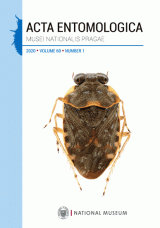Immature stages and biology of the enigmatic oxyporine rove beetles, with new data on Oxyporus larvae from the Russian Far East (Coleoptera: Staphylinidae)
Tokareva Alexandra, Solodovnikov Alexey, Konstantinov Fedor
Acta Entomologica Musei Nationalis Pragae 60(1): 245-268, 2020
Published online: 31st March 2020
Published in print: 15th June 2020
Views: 1624
Abstract: Oxyporinae are a visually attractive and highly specialized mycophagous
subfamily of rove beetles (Staphylinidae) with enigmatic origins and a largely
unknown evolutionary history. Our knowledge of their immature stages and
biology, valuable for solving questions about their phylogeny, is still very
fragmentary. Here, we describe for the first time the larval morphology of
Oxyporus (s. str.) procerus Kraatz, 1879 and O. (Pseudoxyporus) melanocephalus
Kirschenblatt, 1938, both from the Russian Far East. We redescribe the larval
morphology of the widespread O. (s. str.) maxillosus Fabricius, 1775 based on
material, also from the Russian Far East. All larvae are identified based on the
combined evidence from rearing and cox1 barcoding. For O. maxillosus, O.
procerus and O. (P.) melanocephalus we provide some new field and
laboratory-based data on feeding, mating, oviposition, female brood care,
duration of larval development, and behavior. We applied the Atheta-based system
of Ashe & Watrous (1984) to describe and compare the chaetotaxy of these
Oxyporus larvae. We extract the most essential comparable data for all species
of Oxyporus with known larvae from poorly compatible published larval
descriptions with dubious homology assessments for their chaetotaxy. In
addition, data on fungal hosts and beetle biology is summarized for the genus
and provided for each species. New morphological traits are revealed for the
Oxyporus larvae. Significant differences in larval morphology, reproduction
behavior and cox1 barcoding region between the subgenera Oxyporus s. str. and
Pseudoxyporus Nakane & Sawada, 1956 correspond to the morphological
distance between their adults and suggest that they may be potentially elevated
to genus rank.
Key words: Coleoptera, Staphylinidae, Oxyporinae, immature stages, larval morphology, chaetotaxy, brood care, fungivory, mycophagy, Russian Far East, Palaearctic Region
Papers
In memoriam of Professor Miroslav Papáček (1953–2019): biography, memories, bibliography and list of described taxaNew water strider species of Eurymetra from Madagascar (Hemiptera: Heteroptera: Gerridae)Taxonomic catalogue of the family Ochteridae with description of Ochterus papacekisp. nov. from Socotra Island and Tanzania (Hemiptera: Heteroptera)Review of Caryocolum (Lepidoptera: Gelechiidae) from the Russian Altai with description of two new speciesDiscovery of termitophilous rove beetles associated with Formosan subterranean termite Coptotermes formosanus in Taiwan, with the first larval description for the tribe Termitohospitini (Coleoptera: Staphylinidae)Schizaraeus fouquei sp. nov., the first record of Schizaraeus from Peru (Coleoptera: Tenebrionidae: Stenosini)Generic revision of the Microhoriini with new species and synonymies from the Palaearctic Region (Coleoptera: Anthicidae)Review of the genus Coelostoma of Taiwan with description of a new species (Coleoptera: Hydrophilidae)New species of karst-dwelling Pselaphinae from southwestern China (Coleoptera: Staphylinidae)The discovery of the genus Bryanellocoris from Laos, with description of a new species (Heteroptera: Rhyparochromidae)Review of the genus-level names proposed by Johannes Gistel in Chrysomelidae (Coleoptera)Review of the Afrotropical species of the genus Prometopia (Coleoptera: Nitidulidae: Prometopiinae)Depressariidae (Lepidoptera) of the Russian Altai Mountains: new species, new records and updated checklistImmature stages and biology of the enigmatic oxyporine rove beetles, with new data on Oxyporus larvae from the Russian Far East (Coleoptera: Staphylinidae)Anthomyzidae (Diptera) of Taiwan: new species but no new recordsTaxonomy of Guatemalan water beetles in the genus Hydrochus (Coleoptera: Hydrochidae)Revision of Euspilotus, subgenus Platysaprinus, with description of two new species (Coleoptera: Histeridae)Morphology of immature stages of Helophorus (Gephelophorus) auriculatus (Coleoptera, Helophoridae)Three new species of the genus Sphaerobulbus from China (Coleoptera: Staphylinidae)Scobinigaster, a new genus of Lethaeini from Madagascar (Hemiptera: Heteroptera: Rhyparochromidae)Catalogue of type specimens of beetles (Coleoptera) deposited in the National Museum, Prague, Czech Republic. Staphylinidae: Staphylininae: Staphylinini: PhilonthinaCorrect original spelling of Venanides caspicus (Hymenoptera: Braconidae) 